Are there hawks in Texas? If so, how many? Are they resident or migratory? Do they all eat the same thing? In this post, we are investigating hawks in Texas and trying to answer all these questions.
State of Texas

The Lone Star State is in the southern area of central United States on the Gulf of Mexico. It has a real mix of geography from rolling hills, forests, arid deserts and mountains. This mix along with the long coastline along the gulf and the migratory path from Central America means that Texas is an incredible place to see birds. It is second only to California, with 670 reported species of birds on eBird.
What is a Hawk?
A hawk is a bird of prey in the Acciptridae or Buteo families. It could be argued that the Buteo hawks are not really hawks at all. Outside of America, they are called Buzzards. Bird classification tends to be muddy and confusing and this is a classic example. For our investigation, we are exploring any bird with Hawk in the name that has been recorded in the last few years in Texas.
All 13 Hawk Species
Cooper’s Hawk (Accipiter cooperii)


Identification and Size
The Cooper’s Hawk is a medium-sized raptor with the adult plumage being alike for male and female. It is gray on the back and orange on the breast. Younger birds are brown with a pale streaky breast (photo on the right). The female is considerably larger than the male.
Length: 14.6 – 17.7 inches
Wingspan: 24.4 – 35.4 inches
Weight: 7.8 – 24 ounces
Distribution

As shown in the eBird range map above, the Cooper’s Hawk is a Texas resident and it breeds in forested areas but can be seen year round.

Diet
This is a dangerous hawk if you are a smaller bird. It hunts in the air and will pick off small birds in flight.
Interesting Fact
The Cooper’s Hawk might be fast and agile but it pays the price for its aerial acrobatics. They are frequently killed by making a misjudgement and crashing head first into hard surfaces.
Red-shouldered Hawk (Buteo lineatus)


Identification and Size
The Red-shouldered Hawk is a stunning raptor with vibrant red, cream and brown coloring. Under the wings and tail are waves of black and white.
Length: 16.9 – 24 inches
Wingspan: 37 – 43.7 inches
Weight: 17.1 – 27.3 ounces
Distribution

The Red-shouldered Hawk is resident in Texas, more so in the east with fewer sightings in the west. As shown in the eBird distribution chart below, it can be seen all year round but slightly less so during the summer breeding period.

Diet
This is a perching raptor using wires in open country and trees in forests. It has a varied diet and will take what prey presents itself from rodents to frogs and snakes.
Interesting Fact
There are several sub-species of the Red-shouldered Hawk and their plumages varies as well as their size. The Florida sub-species is much paler and the northern form larger.
Red-tailed Hawk (Buteo jamaicensis)


Identification and Size
This hawk has a relatively short tail and the top of the bird is a rich red hue. Pale underneath, the Red-tailed Hawk has some dark barring on the breast and wings with a rough red stripe across the top of the wing and head. The female is larger than the male.
Length: 17.7 – 25.6 inches
Wingspan: 44.9 – 52.4 inches
Weight: 24.3 – 51.5 ounces
Distribution
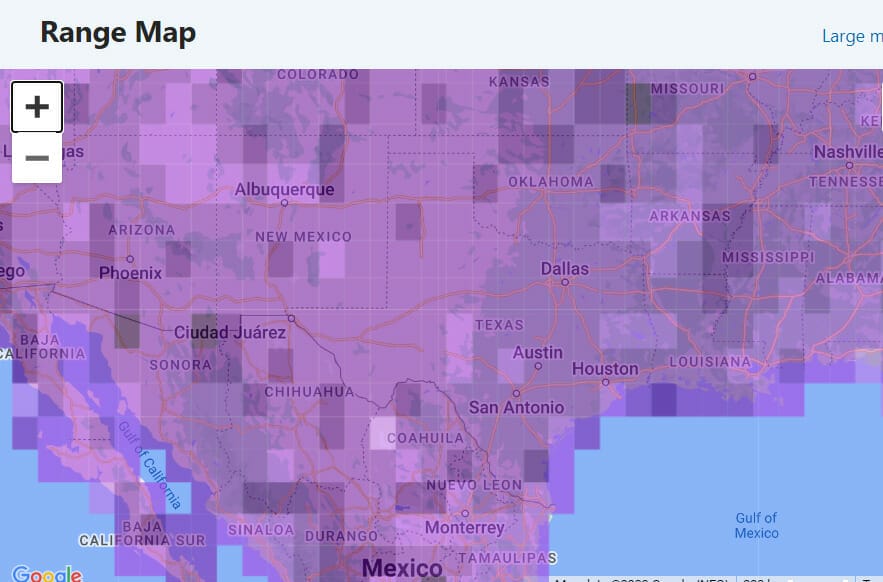
The Red-tailed Hawk is a widespread raptor across the whole of the U.S. It is very regularly seen across the state, all year round.

Diet
The Red-tailed Hawk is a raptor of open country and will be seen along roadsides and above pastures. Consequently it feeds on mammals underneath. These include rabbits and voles.
Interesting Fact
Red-tailed Hawks sometimes hunt as a pair. Four eyes on a tree or rabbit warren are more effective!
White-tailed Hawk (Geranoaetus albicaudatus)

Identification and Size
An unusual looking raptor with a dark head and very fine black and white patterns on the underneath of the wings. The breast is a clean white, as is the tail, except for a black border. The top of the bird is all grey. There may be variations in color, with some adults being lighter.
Length: 18.1 – 20.5 inches
Wingspan: 50.4 – 51.6 inches
Weight: 31.0 – 43.6 ounces
Distribution

The White-tailed Hawk is really a bird of Central and South America. Texas is the only state where it is seen regularly and all year round. Most commonly, sightings are in the south and east of the state.

Diet
The White-tailed Hawk prefers open grasslands to hunt in flight for ground dwelling mammals
Interesting Fact
Some songbirds like mockingbirds are known to nest close to these hawks and it is thought they do this for protection. The White-tailed Hawk will only interfere with them on rare occasions.
Sharp-shinned Hawk (Accipiter striatus)

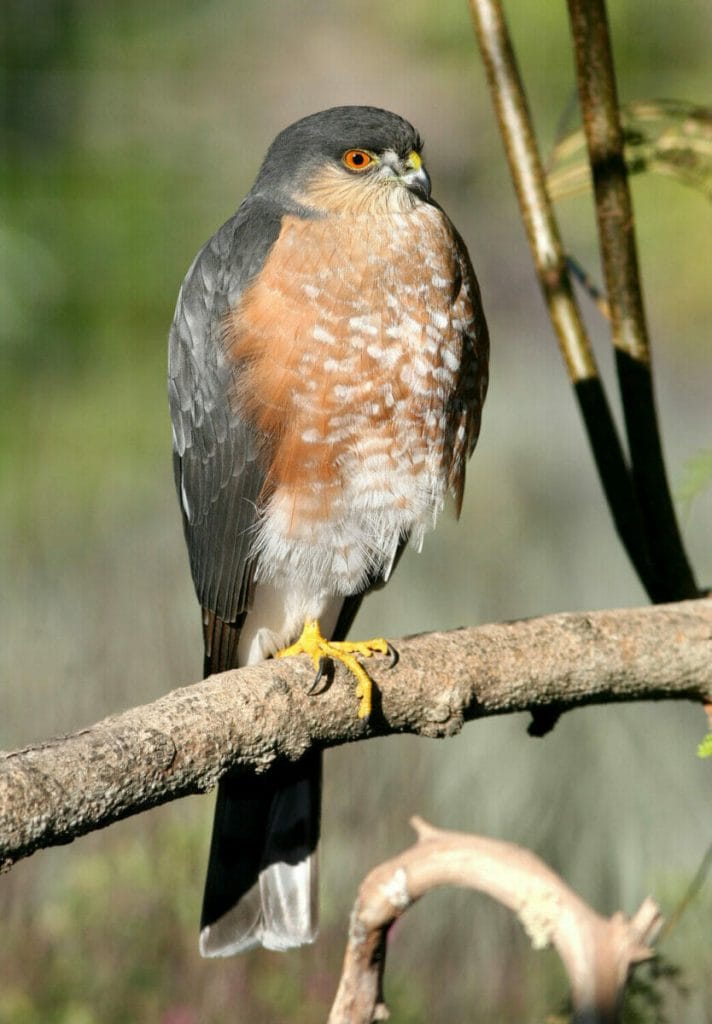
Identification and Size
The Sharp-shinned Hawk is named because it has no feathers on its yellow legs. It is gray on the back and has a cream breast with orange barring, the intensity of which depends on the age of the bird. The female is larger than the male.
Length: 9.4 – 13.4 inches
Wingspan: 16.9 – 22.1 inches
Weight: 3.1 – 7.7 ounces
Distribution

This small hawk is seen across the state. It is present all year round but sightings drop off during the summer breeding months when it returns to Canada to breed.

Diet
This is another agile raptor that finds food in the air, plucking birds in flight. It usually targets songbirds.
Interesting Fact
The sex of the bird dictates which one feeds the chicks. When they are younger and smaller, the male feeds them as he catches smaller birds. When they are bigger, the female brings them larger prey.
Harris’s Hawk (Parabuteo unicinctus)
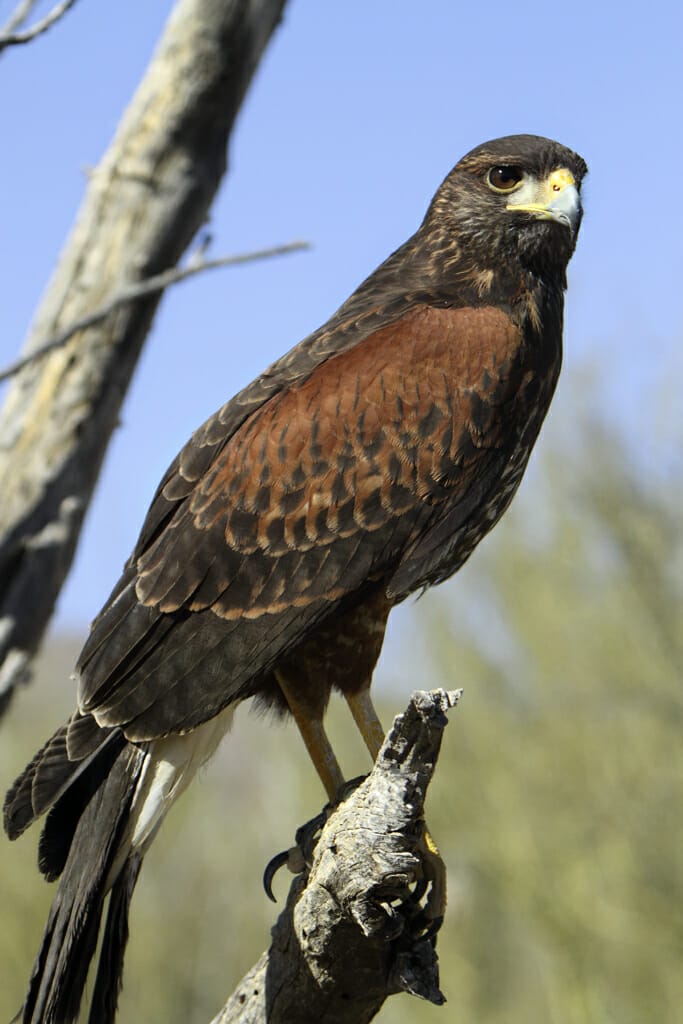

Identification and Size
The Harris Hawk is one the darkest hawks to visit Texas. It has warm red shoulders and dark brown body. The tail has some white in it.
Length: 18.1 – 23.2 inches
Wingspan: 40.5 – 46.9 inches
Weight: 18.2 – 31 ounces
Distribution

The Harris Hawk is present all year round predominately in the west of Texas in arid, desert areas.

Diet
This hawk is another perching predator and will sit and wait for mammalian prey to stray past. It will also visit semi-urban areas to hunt feral pigeons.
Interesting Fact
Unlike most other raptors, the Harris’s Hawk hunts and nests in groups. They co-operate with each other for the benefit of their young and to maximize their hunting potential.
Zone-tailed Hawk (Buteo albonotatus)

Identification and Size
The Zone-tailed Hawk is very dark with interesting patterning underneath. The black fades into silver and black barring. The tail is a distinct black and white striping.
Length: 17.7 – 22.1 inches
Wingspan: 46.9 – 55.1 inches
Weight: 21.4 – 23.5 ounces
Distribution

The Zone-tailed Hawk is reported all year round, albeit in low numbers. It is present only the south western parts of the state. However, it is flexible in its enivronment, surviving in canyons, mountain forest and deserts.

Diet
The Zone-tailed Hawk will soar over open ground looking for smaller bird or mammals to prey upon.
Interesting Fact
This hawk looks a lot like the Turkey Vulture which does not hunt live prey. Researchers think that the Zone-tailed Hawk immitates the vulture to pacify potential live prey.
Grey Hawk (Buteo plagiatus)

Identification and Size
As the name suggests, the Grey Hawk is a pale bird with a solid gray head and body. Underneath there are thin white bars across the breast. The tail has dark and light bands
Length: 18 – 24 inches
Weight: 16.8 ounces
Distribution

The Grey Hawk is an irregular visitor outside of summer months to the far south-western corner of Texas.

Diet
The Grey Hawk sits in forested areas or soars over open country looking for lizards that it can pounce on.
Interesting Fact
During the summer breeding months, these hawks largely withdraw to raise their chicks. However, they can still be heard with a whistling call.
Swainson’s Hawk (Buteo swainsoni)
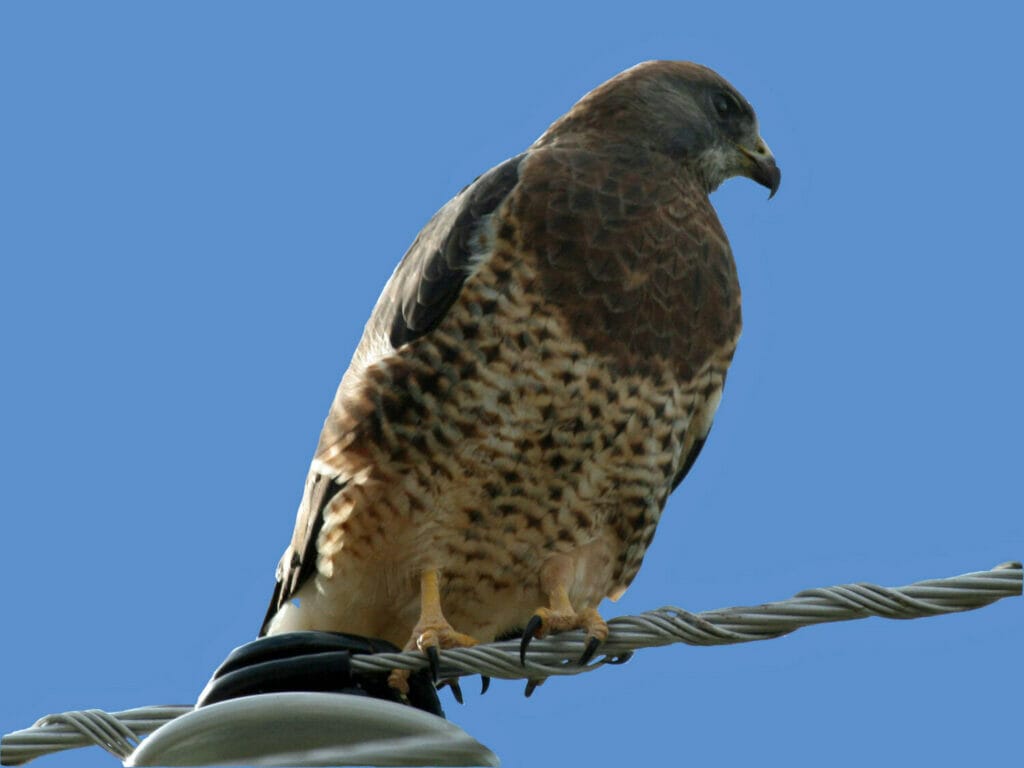
Identification and Size
An attractive and variable hawk with lots of white underneath. The wings are dark on the edges and the tail is barred. A distinctive dark red brown patch at the top of the breast is diagnostic.
Length: 17 – 22 inches
Wingspan: 46 – 54 inches
Weight: 17.6 – 60 ounces
Distribution

The Swainson’s Hawk is seen throughout Texas with more sightings in the western half of the state. It is migratory, spending winters in South America.

Diet
The Swainson’s Hawk hunts for winged insects like grasshoppers and dragonflies at times dives for rodents on the ground.
Interesting Fact
During breeding, the Swainson’s Hawk hunts rabbits, rodents and reptiles to feed to its chicks. Once that job is complete, it switches back to eating insects.
Ferruginous Hawk (Buteo regalis)
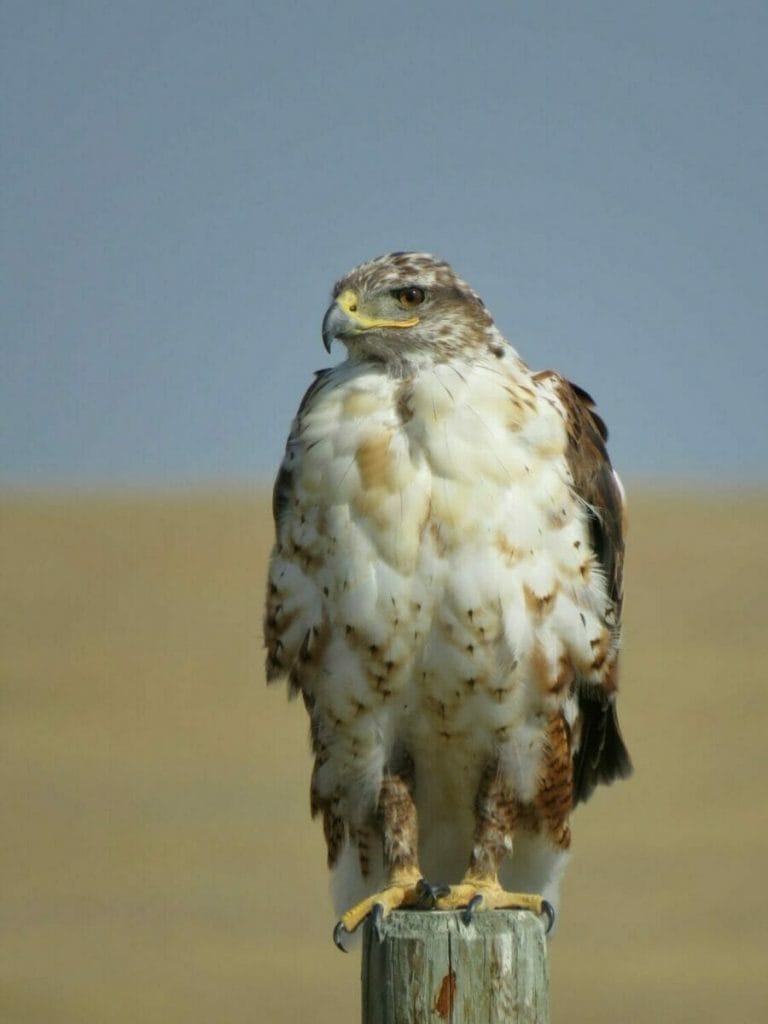

Identification and Size
Another big raptor with a light and dark morph. Pictured here is the more common light morph with rich red coloring on top and pale breast with some streaking.
Length: 22.1 – 27.2 inches
Wingspan: 52.4 – 55.9 inches
Weight: 34.5 – 73.2 ounces
Distribution

An uncommon hawk of Texas, absent from the far east of the state. Reported more in the winter months.

Diet
The Ferruginous Hawk hunts from a high point or as it flies. The diet is mammals including ground squirrels and prairie dogs.
Interesting Fact
These birds work together particularly in winter to hunt, surprise and kill prey.
Common Black Hawk (Buteogallus anthracinus)

Identification and Size
Surprisingly, this hawk is nearly all black. The tail is very short and has a white band halfway down.
Length: 16.9 – 22.1 inches
Wingspan: 46.1 inches
Weight: 27.9 ounces
Distribution

An uncommon species in Texas, seen in patches in the west of the state.

Diet
The Common Black Hawk has an unusual diet. While it will eat carrion and small mammals like other hawks, it prefers crayfish and small vertebrates.
Interesting Fact
When these hawks hunt in water, they will flutter the wings. This surprises their intended prey and while startled, they are easy to catch.
Broad-winged Hawk (Buteo platypterus)

Identification and Size
An unusual looking hawk in that the body is really short, as is the tail. It is brown above with red brown barring on the breast. The thick wings have a rufous tinge under the shoulders and barring across to the tips. Strong stripes are on the tail.
Length: 13.4 – 17.3 inches
Wingspan: 31.9 – 39.4 inches
Weight: 9.3 – 19.8 ounces
Distribution

Seen mostly during summer and fall in Texas and more frequently in the east of the state. It spends winter in Central and South America.

Diet
This forest dwelling hawk is an opportunist and will eat what meat it can find or kill. It will consume anything from small mammals to insects and amphibians.
Interesting Fact
During its migration south, the Broad-winged Hawk flies around 70 miles a day and a total of over 4,000 miles. Once it reaches its destination, it doesn’t move much!
Short-tailed Hawk (Buteo brachyurus)

Identification and Size
This is another small hawk, similar in appearance to other visiting hawks from south of the border. Pictured here is the light morph. A clean, pale breast and wings blend into rufous barring and in the tail. Distinctive dark patches on the face are diagnostic.
Length: 15.3 – 17.3 inches
Wingspan: 32.7 – 40.5 inches
Weight: 13.6 – 16.9 ounces
Distribution
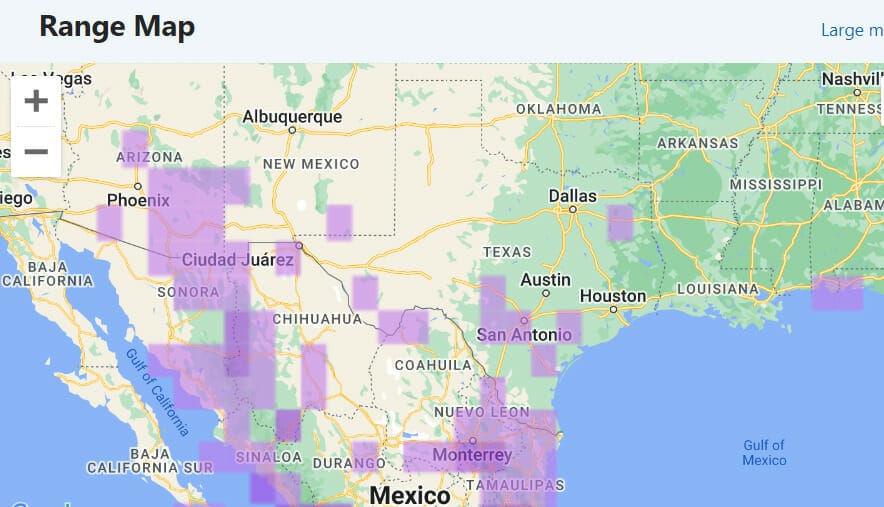
The Short-tailed Hawk is a rare visitor to the very south-west area of the state, although it has been spotted elsewhere at times.

Diet
This hawk is a hunter and feeder of smaller birds. it soars high up and then goes into a steep dive for the kill.
Interesting Fact
There is an isolated population of the Short-tailed Hawk in Florida.
Conclusion
So, we have 13 hawks that are either resident of, or visitors to Texas. They range from small to large, squat to elegant, dark to light. But they all have one thing in common, they are spectacular in their hunting abilities, the flying prowess and their sheer presence across the state. We hope you enjoy our listing.
FAQs
The Red-tailed Hawk is the most common species. They can be seen across the state and throughout the year.
The Ferruginous Hawk is the biggest hawk on our list and for sheer power, it is the most deadly.
Yes, there are several falcons in Texas, including the Peregrine, Bat and Aplomado. Falcons.
In theory, yes they can. Well, the larger ones anyway. In practise, this is unlikely because of the habitat of the cat and the hunting range of the hawk.










